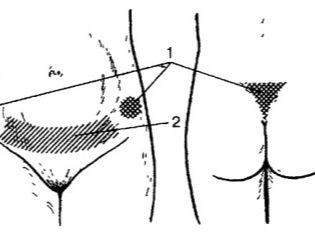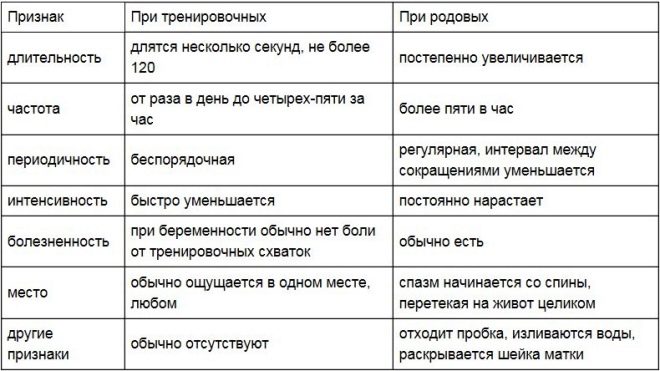What is Braxton-Hicks contractions and what symptoms can they be recognized by?
As soon as pregnant women of Braxton-Hicks fight are called training, false, Higgs fights and “according to Hicks”, “training pants”. Whatever you call them, the essence, by and large, does not change. But the mechanism and symptoms cause a lot of questions. In this material we will tell what it is and how it manifests itself.
The origin and history of the study
The female uterus has an amazing property - it not only increases almost 500 times during a baby’s birth, but can also shrink, almost forcibly expelling the fetus when it comes time for its birth. The musculature of the female reproductive organ is arranged so that it can contract with great force, at the same time the cervix is revealed, and the baby gets the opportunity to leave the comfortable but tight maternal womb. The process of rhythmic and regular involuntary (independent of the will of the woman) contraction is called contractions. They begin the process of childbirth and are of great importance for their outcome.
Training bouquets or Braxton-Hicks contractions with childbirth are not related. They have only a common name.
They represent the tension of the muscles of the uterus, but they never lead to the opening of its neck, the discharge of cork mucous membranes, the outpouring of water, do not affect the timing of the onset of labor. This is a kind of "rehearsal" of the female reproductive system before the actual test. Their women noticed, probably, at all times, but the first doctor who took women's complaints seriously and began to study a strange phenomenon, became the Englishman John Braxton-Hicks, after whom they called false fights. This happened in 1872 in a hospital in London, where the doctor practiced and at the same time wrote numerous scientific works.
One did not take into account the British doctor in his description - the individual characteristics of different women. Therefore, his statements, transmitted to descendants and included in all textbooks on medicine, say that this process is painless. In fact, and women will not allow to lie - not always false fights deliver pleasant or neutral sensations.
Neither John Braxton-Hicks, nor his followers, nor the modern doctors, alas, have been able to establish what the true causes of this phenomenon are. Therefore, until now in medicine there is an opinion expressed in the XIX century, that this is how the organism of the future mother is preparing for childbirth. Doctors have repeatedly questioned this statement, because there are women who for all 9 months have not experienced such contractions once, and this did not prevent their body from preparing for the birth process and normally giving birth on time.
Thus, another version of what was happening was born, saying that short-term episodes of uterine tone enhancement with all the attendant unpleasant sensations depend on the increased sensitivity of the reproductive organ due to intensive growth (more than 500 times - this is not a joke!) And enhanced blood supply. Thus, the brain simply sends erroneous neural signals to the nasty muscles of the female reproductive organ, which is why it comes to tone.
Braxton-Hicks contractions are usually called episodes of uterine tone, which start in advance, long before the expected date of birth. Preparatory, precursor contractions, which are the real "training", during which the cervix begins to mature, are usually divided into a separate group and called preliminary.
But such nuances often go unnoticed even by obstetrician-gynecologists. It is easier for them to call all training bouts in the name of an English doctor than to tell each pregnant woman about the preliminary period and its features.
In principle, women themselves do not really need this information. For them, the main thing is to be able to distinguish training fights from real ones and respond in time to certain pathological changes, if any.
Timing of offensive
Dr. Braxton-Hicks, in the heritage of his descendant colleagues, left another controversial statement that the contractions of his name begin in women in the middle of pregnancy. Therefore, all modern official sources say that to expect the appearance of false contractions should be with the 20th week of pregnancy.
In fact, some women notice short-term episodic spontaneous strains of the reproductive organ even earlier and later, and there are those who endured and begot several children and has no idea what such contractions are, they simply did not feel them.
All these options are variations of the norm. There is an erroneous opinion among future mothers, that the absence of such contractions is a sign that the forces will also be weak in labor and things can end in failure if the cesarean section is not done in time. This statement is not true.
It has long been observed that in primiparous women, training bouts begin earlier than those of mothers with previous childbirth experience. Often, in a second or third pregnancy, a woman feels preparatory muscular activity only immediately before delivery, sometimes only in the preliminary period. A lady who is preparing to become a mother for the first time may well begin to notice such contractions before her 20th week of pregnancy.
Experienced doctors associate this with the structural and physiological differences between the musculature of the uterus in the woman who has given birth and who has not given birth. If there is an experience of childbirth, the muscles are more elastic, stretched, the woman may not feel false contractions until the last weeks of the gestation period. At the first pregnancy, the sensations are more acute.
If the training bouts of the name of the English doctor begin early, there is no reason to panic. Another myth says that it can cause premature birth, but this popular statement also has little to do with the truth.
Symptoms and sensations
If false contractions are not felt, this does not mean that they do not exist. In this matter, it all depends on how sensitive a particular pregnant woman is. In some, as Brexton-Hicks said, everything proceeds without pain and inconvenience, while others feel the tension of the walls of the uterus and this gives them certain discomfort. For reasons unknown to medicine, the same woman can have different sensitivities in different pregnancies. During the first pregnancy, there may be no training contractions, but with the next one they will appear.
Training bout is manifested by sudden involuntary tension of the uterus. In a fairly long time, a woman can even feel the bottom of the uterus herself. Feelings at the time of tension, according to pregnant women, can be completely described by the words “tummy stone hardens”. Due to the sharp tension of the ligament apparatus, pulling and breaking sensations can occur in the lower abdomen and in the lower back.
How long this fight lasts is unambiguously difficult to answer. It can last 15-30 seconds, and can last several minutes. Within an hour of such fights usually does not happen more than 4-5.Often there is one or two, after which the uterus relaxes and the state of health returns to its original state.
Braxton-Hicks contractions are always irregular. No one will tell when they will appear and through how much can happen again.
If suddenly the stresses become regular, it may not be about false, but about the real battles. Pain, if any, during training muscle activity does not increase, but usually declines. It is difficult to say what provokes false contractions, but most often, according to expert observations, the uterus in pregnant women tenses after sex, because arousal and orgasmic sensations lead to minor contractions of the uterine muscles. If a woman does not have other contraindications to a full intimate life during pregnancy, then training fights themselves are not a contraindication to love joys.
If a woman puts herself in perceptible physical exertion: lifts up hard, often bends, rarely rests, walks a lot on the stairs, then false contractions are repeated more often.
The cause of increased tone may be too active movement of the fetus. The frequency of contractions of Braxton-Hicks increases if a woman is under stress, is nervous, and worries a lot. Can affect and full bladder. If it is not possible to empty it at the first request of the organism, then the probability that the internal pressure of the bladder on the wall of the uterus will lead to its short-term tone, becomes higher.
Quite often, women note that contractions of a false type appear in very specific situations after certain actions, for example, only in the mornings or only in the evening, after a woman pulls out after waking up or relaxes before falling asleep.
Impact on pregnancy
On the course of pregnancy, the health of the child and the future mother training exercises have no effect. There is even a hypothesis that after the moment of tension more blood flows to the uterus, and therefore the child receives more nutrients and oxygen. No matter how, no damage from Braxton Hicks contractions, this is exactly what the attending doctors are trying to convey to worrying and impressionable future mothers.
Differences from true
All the same Dr. John Braxton-Hicks argued that confusing false contractions and the present is absolutely impossible. Modern midwives often argue that women should interpret any doubts in favor of false ones, since true contractions leave no doubt about what is happening. To a greater degree, the question of how to recognize false contractions and to distinguish them from the true ones concerns pregnant women, who have very little left before birth. For them we give a comparative table.
How to make it easier?
If Braxton-Hicks contractions are unpleasant, A woman is recommended to try one of the following ways to alleviate the condition.
- Walking The more regular walks at a leisurely pace in the fresh air, the less frequent will be “attending” training episodes of uterine tone.
- New body position. This advice helps most women very effectively. Just change your position. Stand, lie down, walk, sit. You can try everything in turn. Standing in a knee-elbow position with a deflection in the lower back, the so-called “cat pose”, as well as proper breathing - deep and calm, helps.
- Warm shower. Water procedures generally quite effectively remove the uterine tone. If false contractions are repeated often, you can go swimming.
- Medicines. Antispasmodics permitted for use in pregnant women include “No-shpa"And candles with papaverine. But they need to be used only when contractions cause significant inconvenience, and always after consulting a doctor.
If the "workouts" are not too annoying, it is better to ignore them altogether, being distracted by reading, watching movies, listening to music.
When to call an ambulance or go to the doctor?
Too frequent and prolonged bouquets of Braxton-Hicks (more than six hours a day) - a reason for visiting the doctor unplanned. So it will be quieter for everyone. If the contractions become regular, repeat at certain cyclical intervals, increase, there are atypical discharges from the genitals, you should call an Ambulance and go to the maternity hospital. It is possible that labor begins. Especially you need to be attentive before the 36th week of pregnancy so as not to miss the moment of the onset of possible premature birth.
On the false and true fights, see the next video.
































